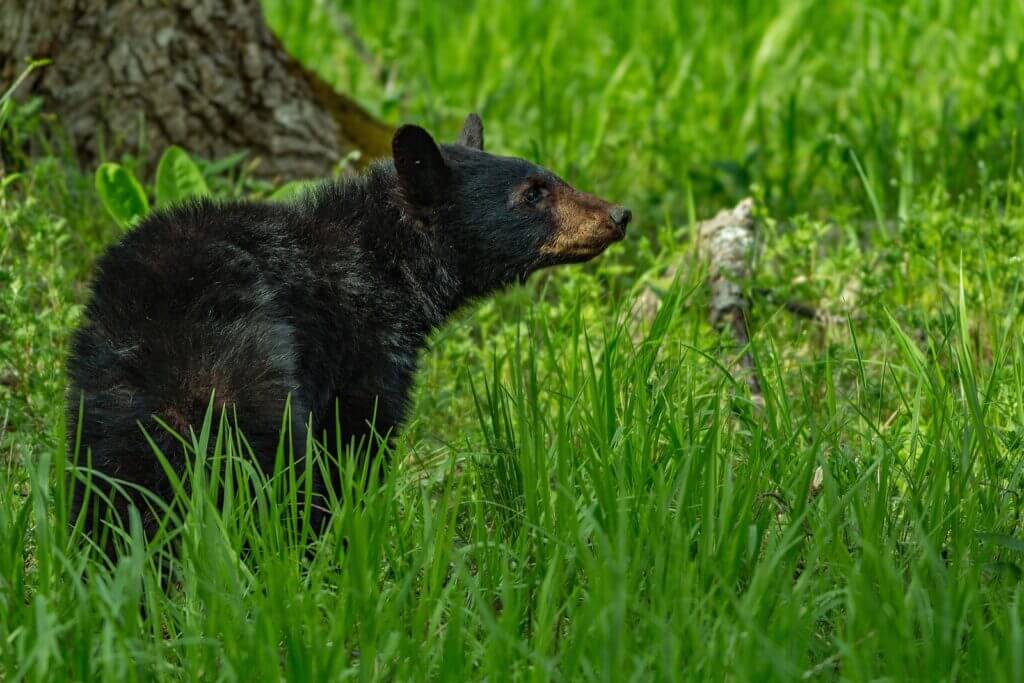Tooth extraction gives biologists crucial information about West Virginia’s black bear population.
Hunters, be aware if you plan to bag a bear—one regulation has more teeth than it used to.
State bear hunting regulations require hunters to extract and submit a black bear’s first premolar tooth. Hunters have until January 31, 2018, to submit teeth from bears killed during 2017. Failure to submit a tooth could result in a misdemeanor offense and fine of up to $1,000.
Colin Carpenter, black bear project leader for the West Virginia Division of Natural Resources, says the agency collects teeth to analyze trends in the state bear population. Once biologists receive a tooth, they submit it to a lab that softens it in acid and slices it up with a microtome.
Rings circle the center of the tooth. Just like on a crosscut tree, one ring equals one year, allowing the DNR to determine the harvested bear’s age. “We reconstruct the bear population of the past that way,” Carpenter says. “So if you kill a 5-year-old bear in 2017, it should have five rings in its premolar, meaning it was born in 2012. From there, we back-build the bear population.”
The DNR has collected bear teeth on a voluntary basis since 1972, but lobbied for about a decade for compulsory tooth submission regulations—requirements already on the books in several other states and Canada. A few years ago, bear hunting groups hopped onboard to support the legislation, and the West Virginia Legislature passed it into law.
The rule went into effect in 2016 and, as soon as it did, tooth submissions jumped to 50 percent, up from just 10 percent the year before.
Carpenter suspects one reason for the previously low rate of submissions is the state’s switch from game checking stations—where DNR staff helped pull bear teeth when hunters took animals in—to a new electronic checking system. “In the rural areas, we had little stores checking game for years, and they did a great job collecting teeth for us. Now as we’re seeing fewer and fewer mom-and-pop stores, our submission rate has declined,” he says.
These days hunters are expected to check game in under the new electronic system, so there’s no one to make sure they send their bear teeth in. That’s why the DNR pushed for stricter rules.
Just Like Pulling Teeth
A black bear’s first premolar teeth are located immediately behind the canine teeth. There are two on the top jaw and two on the bottom. Any of these teeth meet the DNR’s submission requirements.
Teeth are most easily extracted with a wide-blade knife after the bear is freshly killed—it’s best not to wait until the skull and hide are frozen. Cut the gum around the tooth, then place the unsharpened back edge of the blade against one of the large canine teeth so the sharpened edge is against a first premolar. Now, using the canine tooth for leverage, pop the first premolar tooth from the bear’s jaw.
Done correctly, removing these teeth will not damage the skull itself. It’s important not to break the premolar tooth during extraction—broken teeth are unusable for aging purposes.
The DNR encourages hunters to remove two or more teeth from their kills, in case one tooth is lost in the mail. Hunters can mail their bear teeth or deliver them by hand to any DNR district office or the DNR Elkins Operations Center. If submitting by mail, the tooth should be secured to an index card and labeled with the name and address of the hunter, date of the kill, the weapon used, whether dogs were used to kill the bear, the county where the kill took place, the hunter’s DNR ID number, and the game tag number.
Further instructions on how to locate, remove, and submit the first premolar tooth are available in this year’s bear hunting regulations, which can be viewed online at the DNR website. The site also features a helpful video demonstrating the process.
One More Step
But wait. If you’ve killed a female bear, you’re not done playing surgeon. Though not mandatory, the DNR highly recommends removing a female bear’s reproductive tract for submission as well. Wildlife biologists collect these to study breeding ages of females, numbers of cubs produced, age structure of the female population, and reproductive success.
“By looking at the uterus and ovaries from a harvested female, you can determine the age-specific reproductive rate of that animal,” Carpenter says. Instructions and how-to videos on removing the reproductive tract are available on the DNR website.
A hunter shouldn’t submit reproductive tracts through the mail—for obvious reasons. Instead, the tract should be secured in a plastic bag and placed in a refrigerator or freezer until it can be dropped off at a DNR District Office.
The collection of reproductive tracts has confirmed what DNR officials learned from the bear radio collar program: that West Virginia has one of the highest female adult reproductive rates in the black bear range, at 2.67 cubs per female.
written by Jake Stump
photographed by Curt Helmick

